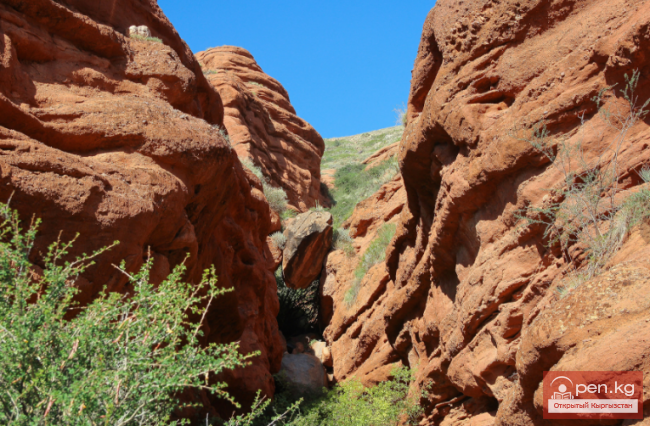Juu Valley (also known as Juku, Zhukuu, Zauka) - one of the most beautiful valleys of the Terskey Alatoo.
It is located south of the village of Saru, which is 10 km west of the village of Pokrovka, approximately 75 km from the city of Karakol.
Juu Valley is the longest on the Terskey Alatoo ridge. The length of the valley reaches 50 km. The length of the valley is due to its unusual shape: in the lower part, the valley stretches strictly from north to south, sharply turning to the west in the upper part. As a result, the Juu-Kuchak River, flowing along the valley, reaches a record length of 55 km for these places.
The valley is famous for its beautiful views and diverse nature. On the slopes of the valley, there are coniferous forests covering more than 30 km. In the lower part of the valley, silent red rocks stand. In the upper part, the valley transforms into a kind of high mountain desert, connecting with the famous Arabel Plateau, which is abundant in lakes (Juu-Kuchak, Juu-Kul, Chokolyk-Köl, Lower, Small, Kashka-Suu, etc.) with amazing shades of water - green, blue, and purple. Looking around, one can see powerful glaciers and the main peak of It-Tash, which is 4808 m high.
The wildlife in Juu Valley is richer than in other Terskey valleys. Herds of ibex - turs number up to a hundred heads. Perhaps this is the only valley on the northern slope of Terskey where, just like in the syrts, there are still argali and stone martens. In the forest zone of Juu, there are many roe deer, and in the alpine meadows, there are snowcocks, koklass pheasants, and bearded partridges.
Some historical monuments found here are interesting - rock paintings from the 6th to 1st centuries BC, stone sculptures, and burials of ancient Turks.

In ancient times, numerous travelers and merchants from different countries passed through here. Throughout various epochs, Scythians, Chinese, ancient Turks, Nestorian Christians, and of course, nomadic Kyrgyz found refuge here. Despite the rugged terrain of the valley, Juu was for a long time the only route from the Issyk-Kul valley to China. The valley also served as a bypass mountain route to the western part of the Tian Shan. The famous monk Xuanzang, one of the main heroes of the Chinese legend about Sun Wukong, visited Juu, as did the renowned traveler Pyotr Semenov-Tyan-Shansky, who witnessed the traces of a terrible battle between the Kyrgyz tribes of Bugus and Sarybagysh, who inhabit the Issyk-Kul valley. In the 7th century, there was a settlement of Nestorian Christians, descendants from faraway Syria, in the valley of the Juu River. Buddhists also left their mark here by engraving their eternal mantra on a huge stone. The suffering and the sick found salvation in the healing springs of the right tributary of Juu - Juu-Kuchak. At the end of the 19th century, in the caves of the red rocks, like a swallow's nest, the Kyrgyz fortress of the Bugy ruler Burumbay was nestled.
And of course, Juu is one of the few places on the shores of Lake Issyk-Kul, famous for its thermal springs!





















































